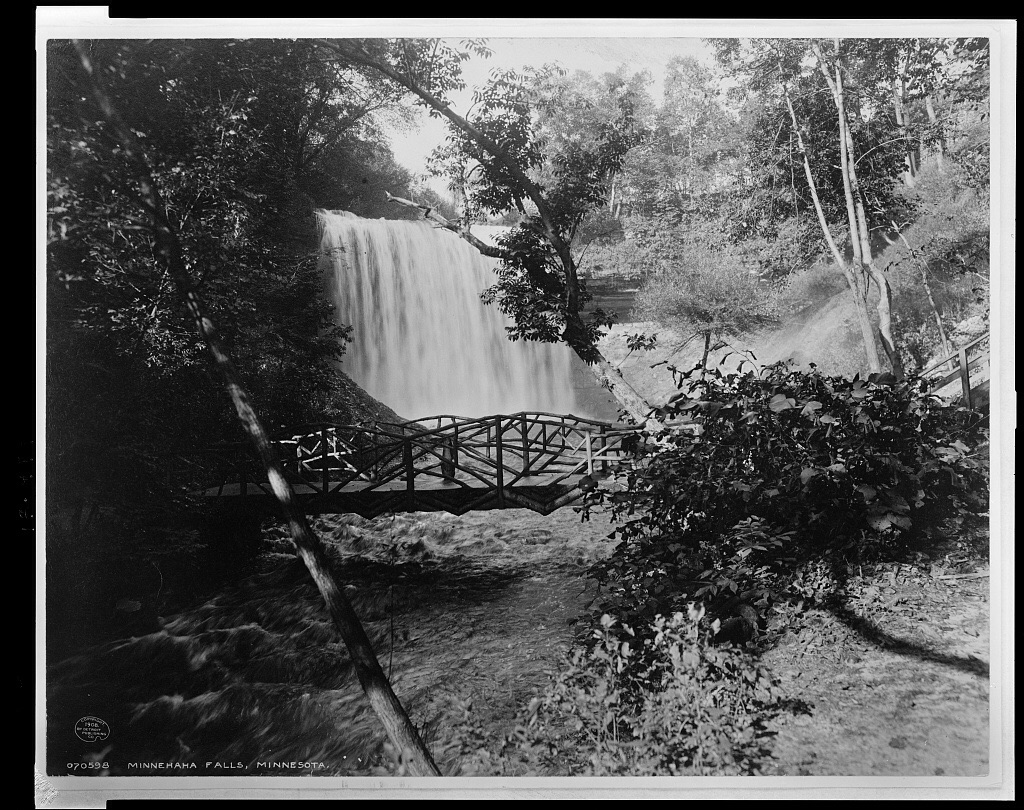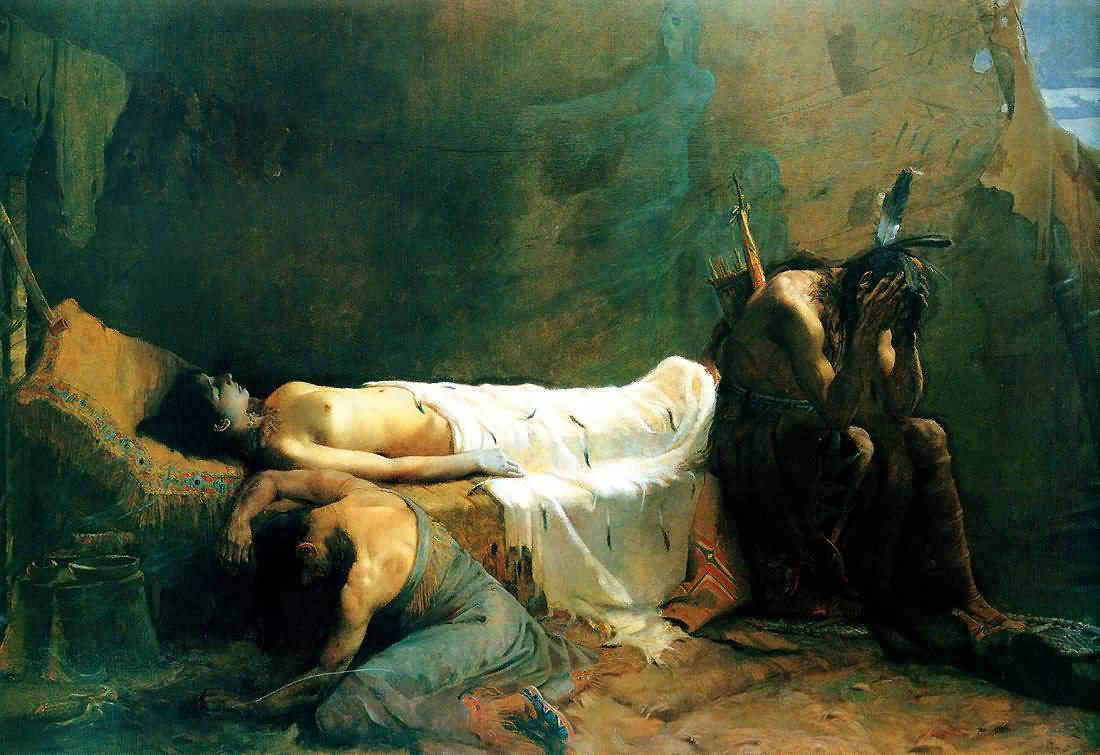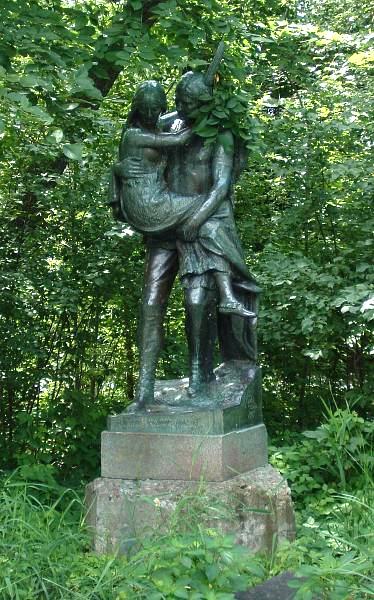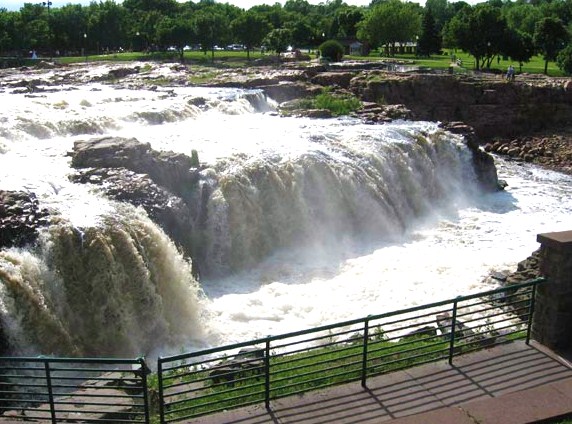|
Minnehaha
Minnehaha is a Native American woman documented in Henry Wadsworth Longfellow's 1855 epic poem ''The Song of Hiawatha''. She is the lover of the titular protagonist Hiawatha and comes to a tragic end. The name, often said to mean "laughing water", literally translates to "waterfall" or "rapid water" in Dakota. The figure of Minnehaha inspired later art works such as paintings, sculpture and music. ''The Death of Minnehaha'' is a frequent subject for paintings. Minnehaha Falls and her death scene inspired themes in the ''New World Symphony'' by Antonín Dvořák. Longfellow's poem was set in a cantata trilogy, ''The Song of Hiawatha'' in 1898–1900 by the African-English composer Samuel Coleridge-Taylor. Longfellow's poem also inspired Hugo Kaun's symphonic poems "Minnehaha" and "Hiawatha" composed in 1901. Minnehaha as a name The character's name has been bestowed upon things, especially in the Great Lakes region of the United States. A ship bearing the name Minnehaha w ... [...More Info...] [...Related Items...] OR: [Wikipedia] [Google] [Baidu] |
Minnehaha Park (Minneapolis)
Minnehaha Park is a city park in Minneapolis, Minnesota, United States, and home to Minnehaha Falls and the lower reaches of Minnehaha Creek. Officially named Minnehaha Regional Park, it is part of the Minneapolis Park and Recreation Board system and lies within the Mississippi National River and Recreation Area, a unit of the National Park Service. The park was designed by landscape architect Horace W.S. Cleveland in 1883 as part of the Grand Rounds Scenic Byway system, and was part of the popular steamboat Upper Mississippi River "Fashionable Tour" in the 1800s. The park preserves historic sites that illustrate transportation, pioneering, and architectural themes. Preserved structures include the Minnehaha Princess Station, a Victorian train depot built in the 1870s; the John H. Stevens House, built in 1849 and moved to the park from its original location in 1896, utilizing horses and 10,000 school children; and the Longfellow House, a house built to resemble the Henry Wad ... [...More Info...] [...Related Items...] OR: [Wikipedia] [Google] [Baidu] |
Minnehaha Falls
Minnehaha Park is a city park in Minneapolis, Minnesota, United States, and home to Minnehaha Falls and the lower reaches of Minnehaha Creek. Officially named Minnehaha Regional Park, it is part of the Minneapolis Park and Recreation Board system and lies within the Mississippi National River and Recreation Area, a unit of the National Park Service. The park was designed by landscape architect Horace W.S. Cleveland in 1883 as part of the Grand Rounds Scenic Byway system, and was part of the popular steamboat Upper Mississippi River "Fashionable Tour" in the 1800s. The park preserves historic sites that illustrate transportation, pioneering, and architectural themes. Preserved structures include the Minnehaha Princess Station, a Victorian train depot built in the 1870s; the John H. Stevens House, built in 1849 and moved to the park from its original location in 1896, utilizing horses and 10,000 school children; and the Longfellow House, a house built to resemble the Henry Wad ... [...More Info...] [...Related Items...] OR: [Wikipedia] [Google] [Baidu] |
Minnehaha Feeding Birds
Minnehaha is a Native American woman documented in Henry Wadsworth Longfellow's 1855 epic poem ''The Song of Hiawatha''. She is the lover of the titular protagonist Hiawatha and comes to a tragic end. The name, often said to mean "laughing water", literally translates to "waterfall" or "rapid water" in Dakota. The figure of Minnehaha inspired later art works such as paintings, sculpture and music. ''The Death of Minnehaha'' is a frequent subject for paintings. Minnehaha Falls and her death scene inspired themes in the ''New World Symphony'' by Antonín Dvořák. Longfellow's poem was set in a cantata trilogy, ''The Song of Hiawatha'' in 1898–1900 by the African-English composer Samuel Coleridge-Taylor. Longfellow's poem also inspired Hugo Kaun's symphonic poems "Minnehaha" and "Hiawatha" composed in 1901. Minnehaha as a name The character's name has been bestowed upon things, especially in the Great Lakes region of the United States. A ship bearing the name Minnehaha wr ... [...More Info...] [...Related Items...] OR: [Wikipedia] [Google] [Baidu] |
The Song Of Hiawatha
''The Song of Hiawatha'' is an 1855 epic poem in trochaic tetrameter by Henry Wadsworth Longfellow which features Native American characters. The epic relates the fictional adventures of an Ojibwe warrior named Hiawatha and the tragedy of his love for Minnehaha, a Dakota woman. Events in the story are set in the Pictured Rocks area of Michigan on the south shore of Lake Superior. Longfellow's poem is based on oral traditions surrounding the figure of Manabozho, but it also contains his own innovations. Longfellow drew some of his material from his friendship with Ojibwe Chief '' Kahge-ga-gah-bowh'', who would visit at Longfellow's home. He also had frequent encounters with Black Hawk and other Sauk people on Boston Common, and he drew from ''Algic Researches'' (1839) and other writings by Henry Rowe Schoolcraft, an ethnographer and United States Indian agent, and from ''Heckewelder's Narratives''. In sentiment, scope, overall conception, and many particulars, Longfellow insi ... [...More Info...] [...Related Items...] OR: [Wikipedia] [Google] [Baidu] |
Museum Of Lake Minnetonka
''Minnehaha'' is a steam-powered excursion vessel on Lake Minnetonka in the U.S. state of Minnesota. The vessel was originally in service between 1906 and 1926. After being scuttled in 1926, ''Minnehaha'' was raised from the bottom of Lake Minnetonka in 1980, restored, and returned to active service in 1996. The vessel operated uninterrupted on Lake Minnetonka until 2019. It is currently stored in a maintenance facility in the town of Excelsior. History ''Minnehaha'' was built by the Twin City Rapid Transit Company (TCRT) in 1906 and provided fast and reliable transportation for the residents of Lake Minnetonka during much of the early twentieth century. She ran alongside five identical sister vessels named ''Como'', ''Harriet'', ''Hopkins'', ''Stillwater'', and ''White Bear''. TCRT had commissioned boat builder Royal C. Moore to design these "Express Boats" in 1905. Each were long, wide, drew of water, and were powered by a single coal-fired boiler and triple-expansion st ... [...More Info...] [...Related Items...] OR: [Wikipedia] [Google] [Baidu] |
Minnehaha Academy
Minnehaha Academy (often abbreviated MA) is a Christian private school in Minneapolis, Minnesota, United States, for students in preschool through 12th grade, and established in 1913. There are two campuses, the South Campus for preschool through 8th graders, and the North Campus, for 9th through 12th graders. It is a ministry of the Northwest Conference of the Evangelical Covenant Church, and is located in the Cooper and Hiawatha neighborhoods on West River Parkway. The student body is drawn from Minneapolis, St. Paul, and throughout the Minneapolis–Saint Paul metropolitan area, as well as several international students. History In 1884, Rev. Erik August Skogsbergh had a vision for education that inspired Minnehaha Academy. He believed in the importance of quality education with Christian faith as its center. The original incorporation from 1905 stated: “The purpose of this institution shall be to furnish young men and women with the essential elements of a liberal educa ... [...More Info...] [...Related Items...] OR: [Wikipedia] [Google] [Baidu] |
Minnehaha County, South Dakota
Minnehaha County is a county on the eastern border of the state of South Dakota. As of the 2020 census, the population was 197,214, making it the state's most populous county. It contains over 20% of the state's population. Its county seat is Sioux Falls, South Dakota's largest city. The county was created in 1862 and organized in 1868. Its name was derived from the Sioux word ''Mnihaha,'' meaning "rapid water," or "waterfall" (often incorrectly translated as "laughing water"). Minnehaha County is part of the Sioux Falls Metropolitan Statistical Area, the state's largest. Geography Minnehaha County lies on the east side of South Dakota. Its eastern boundary abuts Minnesota as well as the northern and western boundaries of Iowa. The Big Sioux River flows south-southeast through the east central part of the county. Its terrain consists of rolling hills, devoted to agriculture except around built-up areas, and dotted with lakes and ponds in its western portion. Its terrain gene ... [...More Info...] [...Related Items...] OR: [Wikipedia] [Google] [Baidu] |
Lake Minnetonka
Lake Minnetonka (Dakota: ''Mní iá Tháŋka'') is a lake located about west-southwest of Minneapolis, Minnesota. Lake Minnetonka has about 23 named bays and areas. The lake lies within Hennepin and Carver counties and is surrounded by 13 incorporated municipalities. At , it is Minnesota's ninth largest lake. It is a popular spot for local boaters, sailors, and fishermen. History Early history The first people who inhabited the Lake Minnetonka area were indigenous natives who migrated to the region at the end of the last ice age circa 8000 BCE. Later peoples who inhabited the area between 3500 BCE and 1500 CE are commonly referred to collectively as the "Mound Builders" because they constructed large land features serving spiritual, ceremonial, burial, and elite residential functions. The Mound Builder culture reached its apex circa 1150 CE and ceased to exist circa 1500 CE. By the 1700s Lake Minnetonka was inhabited by the Mdewakanton people, a subtribe of the Dak ... [...More Info...] [...Related Items...] OR: [Wikipedia] [Google] [Baidu] |
Hiawatha And Minnehaha
''Hiawatha and Minnehaha'' is a sculpture by Jacob Fjelde that has stood in Minnehaha Park in Minneapolis since the early twentieth century. Now a popular fixture of the park, its placement there was originally controversial. In 1855, Henry Wadsworth Longfellow published a book-length poem entitled ''The Song of Hiawatha''. Longfellow never visited Minnesota, but he set his poem among the Ojibwe and Dakota of the region. The poem's story line was based on traditional Haudenosaunee (Iroquois) tales, as recorded, sometimes incorrectly, by Henry Rowe Schoolcraft. ''The Song of Hiawatha'' was widely read and had significant cultural influence in the United States through the rest of the nineteenth century and into the twentieth century. Accomplished Norwegian sculptor Jacob Fjelde immigrated to Minnesota in 1887, following family members to the area. He established a studio in Minneapolis and began receiving public and private commissions. One commission was to create a sculpture for ... [...More Info...] [...Related Items...] OR: [Wikipedia] [Google] [Baidu] |
Minnehaha Creek
Minnehaha Creek ( dak, Mniȟáȟa Wakpádaŋ) is a 22-mile-long (35 km) tributary of the Mississippi River that flows east from Gray's Bay Dam on Lake Minnetonka through the suburban cities of Minnetonka, Hopkins, Saint Louis Park, and Edina, and the city of Minneapolis. The creek flows over Minnehaha Falls in Minnehaha Park near its mouth at the Mississippi River. History As with much of the Midwest, the area around the creek and Lake Minnetonka was originally inhabited by a native culture affiliated with the Mound Builders, but by the 1700s was occupied by the Mdewakanton People, a sub-tribe of the Dakota. The first Euro-Americans whose expedition to the area was documented were Joe Brown and Will Snelling, who canoed up the creek from Fort Snelling Fort Snelling is a former military fortification and National Historic Landmark in the U.S. state of Minnesota on the bluffs overlooking the confluence of the Minnesota and Mississippi Rivers. The military site was initi ... [...More Info...] [...Related Items...] OR: [Wikipedia] [Google] [Baidu] |
Minnehaha, Washington
Minnehaha is a census-designated place (CDP) in Clark County, Washington, United States. The population was 9,771 at the 2010 census, up from 7,689 at the 2000 census. Name meaning This area got its name from a ''Columbian'' newspaper editorial in 1891. The editor wrote about Burnt Bridge Creek and called it "Minnehaha, laughing water," from Longfellow's poem "The Song of Hiawatha". The name appealed to the citizenry and they kept it. Before that the area was called the "Black Forest" for its thick timber. While ''Minnehaha'', a Native American word, is often translated as "Laughing Water", the correct translation is "curling water" or "waterfall", as in Minnehaha Falls, Minnesota. The name comes from the Dakota language. Geography Minnehaha is located in southwestern Clark County at (45.656, -122.622). It is bordered on the west, south, and east by the city of Vancouver and on the north by Walnut Grove. According to the United States Census Bureau, the Minnehaha CDP has ... [...More Info...] [...Related Items...] OR: [Wikipedia] [Google] [Baidu] |
Death-Of-Minnehaha Dodge
"The Death of Minnehaha" was a part of Henry Wadsworth Longfellow's 1855 poem ''The Song of Hiawatha''. It was rendered by the painter William de Leftwich Dodge in 1892, as the painting ''Death-Of-Minnehaha''. Later the poem was arranged by Charles Crozat Converse into a popular song. It was also the second part (composed 1899) of the cantata trilogy ''The Song of Hiawatha'' by the English composer Samuel Coleridge-Taylor Samuel Coleridge-Taylor (15 August 18751 September 1912) was a British composer and conductor. Of mixed-race birth, Coleridge-Taylor achieved such success that he was referred to by white New York musicians as the "African Mahler" when .... References * Poetry by Henry Wadsworth Longfellow {{song-stub ... [...More Info...] [...Related Items...] OR: [Wikipedia] [Google] [Baidu] |








